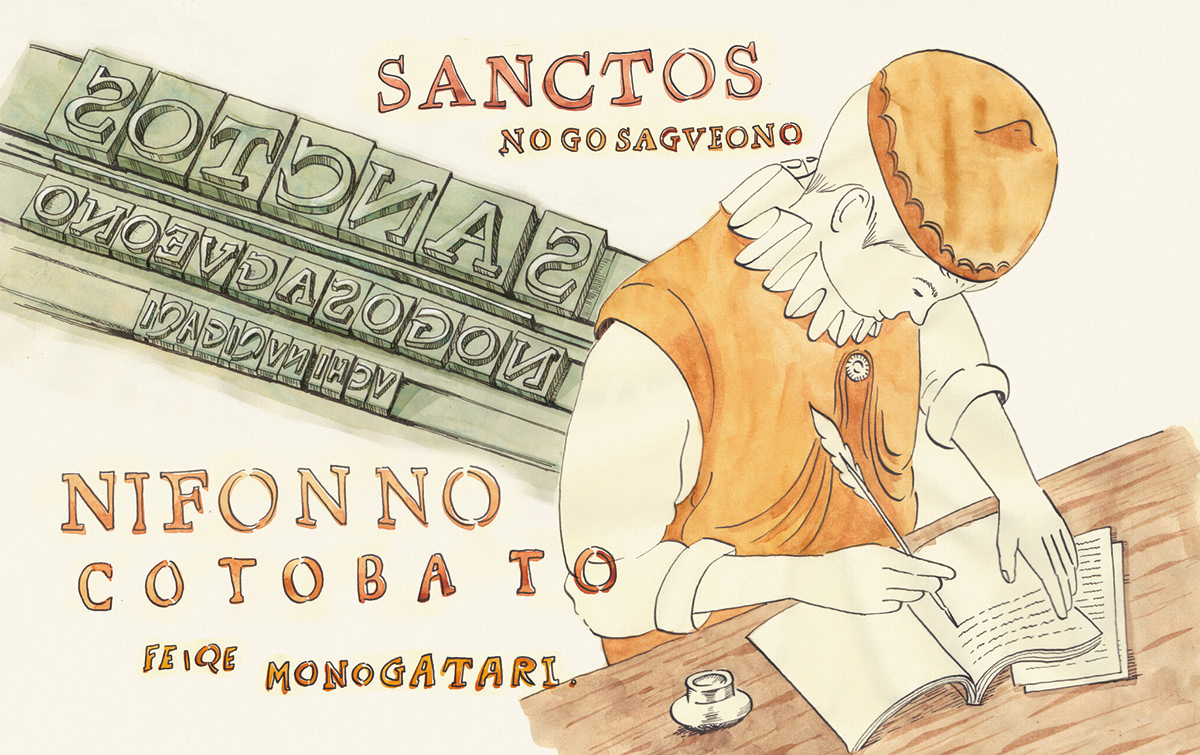
Fukusaya
This advertisement looks back at the history of the introduction of sponge cake to Nagasaki in the series 'Castellike Nagasaki'. I was conscious of the vintage feel of the image and drew it on light brown washi-like paper, and I used a variety of my own ideas to draw it. As it was a historical event, it was difficult to find materials, and there were times when I used period dramas and films as references for my drawings. It is a series of 12 issues, four a year for three years. It has been published in Katei Gaho, ANA Winged Kingdom and Nagasaki Shimbun.
・
Part 1: "Overcoming great seas and difficulties, the boys arrived Rome." The four members of the Tensho Boys' Mission to Europe departed from Nagasaki and arrived in Rome.

・
Part 2: "On that journey, the boy met 'printing'." Dourado, a member of the delegation, encounters letterpress printing in Lisbon and brings the technique back to Japan.

・
No. 3 'Faith is eternal' (The Discovery of the Faithful) by Father Petitjean,
a missionary at the Oura Tenshudo in Nagasaki under the prohibition of the Church.

・
Part 4: "Master VALIGNANO's hospitality, the Namban way."
The missionary Valignano proselytised Christianity by presenting Oda Nobunaga and others with Nanban sweets.
The missionary Valignano proselytised Christianity by presenting Oda Nobunaga and others with Nanban sweets.

・
Part 5: "A Spanish pastry with a future called Castella."
The Nagasaki Castella has its roots in the monastery confectionery 'bischoco'.

・
Part 6: "The Shoguns' honzen cuisine and the Nanban pastry castella." During the Edo period, the sweet of the Shichi-Go-Honzen, the best Tokugawa-style Shijo-style menu, was castella.

・
Part 7: "Nuns' biscochos are made by the separate method"
The 'separate standing method', in which the egg yolks and egg whites are separated and stirred separately, was introduced to produce a fluffy sponge cake-like pastry.
The 'separate standing method', in which the egg yolks and egg whites are separated and stirred separately, was introduced to produce a fluffy sponge cake-like pastry.

・
Part 8: "Days with Castella, by Jesefa de Ayala."
The 17th-century painter Joséfa painted many scenes of everyday life in the monastery.
Some of these depict castella-like pastries. (This picture is my own painting of Josefa's painting.)
Some of these depict castella-like pastries. (This picture is my own painting of Josefa's painting.)

・
No. 9 "Delicacies are also 'new day by day'" Nagasaki Fukusaya was founded in 1624. In the same year, wine was made in an old castle built in Romania. The manufacturing of a long-established company that takes on the challenge with a renewed spirit and untiring creativity.

・
Part 10: "For four hundred years, we have been protecting and carrying on a much-loved craftsmanship."
The world's oldest pharmacy in Florence and Fukuzaya, both continue to produce excellent products today using recipes and techniques handed down for 400 years.
The world's oldest pharmacy in Florence and Fukuzaya, both continue to produce excellent products today using recipes and techniques handed down for 400 years.

・
11th "Pray for safety and peace, pray for safety and good health."
Shoki is the god of protection against evil spirits. May the world be blessed with peace and security in everyday life as soon as possible...
Shoki is the god of protection against evil spirits. May the world be blessed with peace and security in everyday life as soon as possible...

・
Vol. 12: "From west to east, east to west. Craftsmanship is handed down from west to east and east to west."
Arita porcelain was exported to Europe in the 17th century and became very popular. At the same time, castella was introduced to Nagasaki.
Both Arita-yaki porcelain and Fukusunaya sponge cakes have been preserved over the past four centuries.
Arita porcelain was exported to Europe in the 17th century and became very popular. At the same time, castella was introduced to Nagasaki.
Both Arita-yaki porcelain and Fukusunaya sponge cakes have been preserved over the past four centuries.




